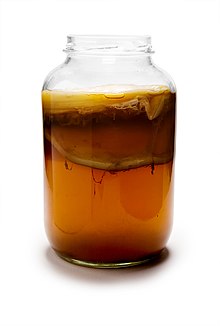Tales from the Lab #6: The Thing from the Tea
In all the labs I’ve worked in, there has been one major constant when it comes to people who aren’t microbiologists: They are both fascinated and repulsed by the work we do. We grow bacterial and fungal cultures on a regular basis, and some of those cultures aren’t exactly pleasant to behold (or smell, if you’ve read the “How to Clear a Micro Lab” post). Because of this, or in spite of it, the non-microbiologists I’ve worked with are either a) terrified to go into the micro lab, or b) go out of their way to give us “special projects” – often from their refrigerators at home.
This month’s episode of Tales from the Lab comes from my first job out of college. It was 2006 or 2007, and kombucha tea had just become a novelty item in our area. To give a bit of background, kombucha tea is a fermented drink, and that fermentation is made possible by a symbiotic colony of bacteria and yeast (usually Saccharomyces cerevisiae, also known as brewer’s yeast, and Gluconacetobacter xylinus bacteria).

Many people call that colony a “mushroom”, but it’s not actually a mushroom. Yeast are fungi, and mushrooms are fungi, but they don’t belong to the same category within the fungal kingdom. I won’t bore you with a taxonomy lesson, because I’m sure you have better things to read.
Anyway, if you’ve ever had the privilege of looking at traditionally brewed kombucha tea, you can see the colony within the liquid. It looks nothing like a mushroom, and very much like an overgrown biofilm, which in a sense, is what it is. (To me, it doesn’t look appetizing, but there are a number of claims that the tea has health benefits – even though science hasn’t been able to back those up).
One of my coworkers had recently learned of kombucha tea, heard of its purported benefits, and decided to give it a try. What she was not aware of was the “mushroom” portion of the drink. She bought a few bottles, happened to bring one into work with her, and after opening it and looking inside, had a few moments of terror before bringing the bottle (untasted) into the micro lab. She was convinced the tea was bad, and the enormous, slimy mass at the bottom of the bottle was the result of spoilage. Bacteria tend to spoil things, so coming to the microbiologists to learn what had happened seemed a natural solution to her. (This was not the first time in my career that a similar situation had occurred, and it certainly was not the last. Remember the coffee mold?)
Fortunately for our coworker, the lead microbiologist was familiar with kombucha tea and was able to explain to her that the “thing” in her tea was supposed to be there. Without that mat of yeast and bacteria, the drink wouldn’t be fermented (the same goes for any alcohol you might consume – thank your brewer’s yeast for providing you with that buzz!) For those concerned about kombucha consumption at work, the commercial varieties generally have less than 0.5% alcohol by volume (compare that to wine, which ranges from around 6% to 23%).
Unfortunately for our coworker, who was by now calmed down and ready to drink her tea, we couldn’t let her do so. Once an item enters the microbiology lab space, there’s a potential contamination risk due to the live cultures that may be stored or actively growing, so it was no longer considered safe to drink. At least she had a couple more bottles at home to try.
Like reading Tales from the Lab? You can read previous installments here.
Thanks for following, reading, and for your continued support!
